소아청소년들의 균형 잡힌 음식물과 소아청소년들의 하루 수면시간과 낮잠 자는 시간 Balanced diets for children and adolescents and average sleeping hour and nap time daily
히포크라테스는 “음식물은 보약이다 Let food to be medicine “라고 했다.
- 균형 잡힌 좋은 음식물은 바로 몸과 마음을 건장하게 하는 둘도 없는 보약이다.
-
“음식물은 사랑(Food is love)”란 말도 있다. 사랑 없이 살 수 없고 음식물 없이 살 수 없다.
-
갓 태어난 내 소중한 아기에게 먹일 수 있는 가장 좋은 음식물은 두 말할 것 없이 바로 엄마의 젖(모유)이다.
-
인공영양을 먹여 내 아기 자녀를 양육하는 대신 내 젖을 먹여 나의 아기 자녀를 양육하는 방법은 엄마뿐만 아니라 아빠와 아기 자녀, 가족, 더 나아가서는 국가와 사회 모두에게 유익하다.
-
인공영양(Infant Formula)을 먹여 아기를 키우는 것 보다 모유를 수유해 아기를 키우는 것은 경제적이다.
-
뿐만 아니라 정신, 신체, 정서적인 면에서도 아기, 수유모, 아빠, 가족 모두에게 유익하다.
-
특히 엄마 아빠 자식 간의 정서적 안정감을 도모하는데도 모유수유의 역할은 대단하다.
-
엄마의 젖을 먹고 성장한 아이는 인간성도 좋고 대인관계를 원활하게 하고 생산적인 성인으로 성장한다. 그 외 모유수유의 좋은 점은 너무도 많다.
-
신생아들과 영유아들을 건강하게 키우는 데 가장 좋은 음식물이 바로 모유이다.
-
엄마의 젖을 먹고 자라는 어린 영유아 자녀들은 각종 감염병과 질병에 덜 걸리고, 질병에 걸려도 잘 투병할 수 있다.
-
모유는 보약 중 가장 좋은 보약이다.
-
건강하게 잘 성장 발육할 수 있게 균형 잡힌 영양 음식물을 충분히 섭취하는 것도 일종의 소아청소년의 예방이다.
-
균형 잡힌 영양 음식물을 충분히 섭취해 강건하게 키우는 것은 엄마아빠의 책임이고 의무이다.
-
탄수화물, 단백질, 지방질, 채소, 과일, 수분, 비타민, 미네랄 등의 영양분이 골고루 들어 있는 음식물을 나이에 적절하게 충분히 섭취하는 것을 “균형 잡힌 영양 음식물을 섭취한다.”라고 말할 수 있다.
-
그날그날 일상생활을 하는데 필요로 하는 총 에너지의 대부분은 아침 식사에서 공급 받아야 한다.
-
그 때문에 아침 식사를 거르지 말고 꼭 먹어야 한다.
-
하루 24시간 동안 모든 식사 중 가장 중요한 식사가 바로 아침 식사이다.
-
아침 식사는 그날 활동에 필요로 하는 주 에너지 자원이 되고 주축과 같다.
-
나이에 따라 섭취해야 할 음식물의 종류 및 질과 양, 먹어야 하는 횟수, 모유, 인공영양, 이유식, 비타민 등에 관해 더 자세한 정보는 [부모도 반의사가 되어야 한다–소아가정간호 백과]-제 4권 모유, 모유수유, 이유 참조.
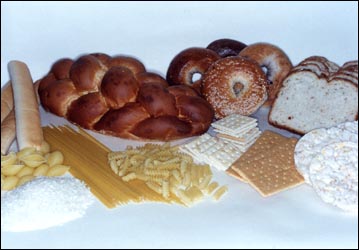
사진 1-9. 탄수화물류 음식물.
쌀, 감자, 보리, 밀, 고구마 들의 음식물은 탄수화물류의 주성분이다.
Copyright ⓒ 2012 John Sangwon Lee, MD., FAAP
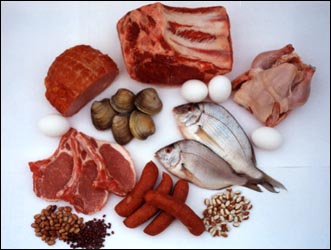
사진 1-10. 단백질류 음식물.
쇠고기, 돼지고기, 닭고기, 생선, 두류, 우유 등은 단백질류 음식물들이다.
Copyright ⓒ 2012 John Sangwon Lee, MD., FAAP
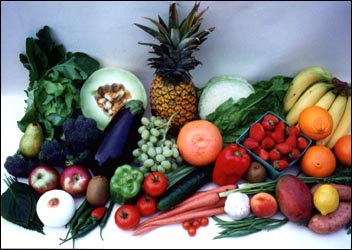
사진 1-11. 과일류와 채소류 음식물.
토마토, 귤, 참외, 빠나나, 딸기, 사과, 복숭아, 양파, 고추, 가지, 배추, 무, 쪽파, 포도, 시금치 등은 과일류와 채소류 음식물이다.
Copyright ⓒ 2012 John Sangwon Lee, MD., FAAP
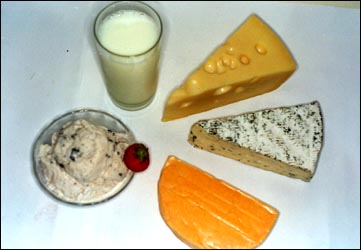
사진 1-12. 우유와 우유제품 음식물이 체질에 맞으면 좋은 음식물이다. 우유의 87% 는 물이고 나머지의 성분은 유당, 버터 지방, 우유 단백질과 캴슘, 소듐 등 미네랄과 비타민 등이 조금씩 들어 있다.
Copyright ⓒ 2012 John Sangwon Lee, MD., FAAP
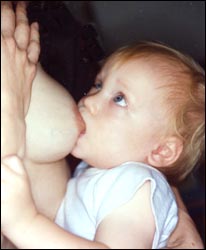
사진 1-8. 모유는 단백질, 탄수화물, 지방, 비타민, 미네랄, 수분 등이 골고루 든 균형 잡힌 최고 자연음식물이다. 특히 엄마의 젖 속에는 사랑이 가득히 많이 들어있다. 그것뿐만 아니라 젖을 먹이는 엄마의 정신적 육체적 건강에도 아주 좋다. 모유수유를 하는 동안 아기자녀의 눈길 접촉 사랑을 보라. Copyright ⓒ 2012 John Sangwon Lee, MD., FAAP
2021년 미 농업, 보건 복지부의2세 이전 영유아 음식물 최신가이드라인
- 소아청소년들의 비만과 천식을 예방하기 위해 모유수유를 특히 권장한다.
- 성장 발육에 특별히 필요한 철분 캴슘이 들어 있는 음식물을 먹도록 한다.
- 알레르기를 잘 이르키는 음식물을 생후 6개월 부터 먹이기시작 한다.
- 땅콩 알레르기 음식물은 생후 4~6개월 부터 먹이기 시작 한다.
- 과일 쥬스나 설탕이 든 과일 쥬스는 1세 이전에는 주지 않는다.
- 영유아 이후 철분, 캴슘, 비타민 D 등 미네랄 비타민 등이 들어 있는 채소 과일 등 균형 잡힌지중해 식 음식물을 준다. 소스; AAP News 2/2021
소아청소년들의 충분한 수면 Enough sleep for children and adolescents
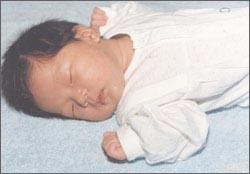
사진 1-13. 충분한 수면은 정신 육체 건강을 최상으로 유지하는데 꼭 필요하다. 신생아들이나 초기 영아들을 재울 때 바닥에 등을 대고 눕혀 재운다. Copyright ⓒ 2012 John Sangwon Lee, MD., FAAP
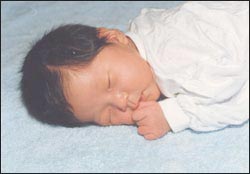
사진 1-14. 신생아들이나 초기 영아들을 재울 때 바닥에 배를 대고 엎어 눕혀 재우는 수면체위를 권장하지 않는다. 의식주 건강, 사랑, 수면은 인간에 가장 필요한 기본 조건들이다.
Copyright ⓒ 2012 John Sangwon Lee, MD., FAAP
-
개인, 나이, 환경, 생활양식 등에 따라 최상 건강을 유지하는데 필요한 하루 평균 총 수면시간은 정상적으로 조금씩 차이가 난다.
-
때문에 건강에 가장 좋은 하루 평균 총 수면시간은 나이, 성별, 생활양식 등에 따라 똑같을 수 없다.
-
태어나서 첫 4주까지 신생아기 대부분의 신생아들의 하루 평균 총 수면시간은 15~18시간이다. 다른 연구에 의하면 평균 20시간이다.
-
신생아기 아기들의 하루 일과는 먹고 대소변을 보고 자고 깨어 울고 놀고 자는 것이 전부인 것 같다.
-
어떤 신생아들은 잠자는 시간과 깨어 있는 시간이 확실히 분별되지 않는다.
-
생후 첫 4주 동안 신생아들의 “하루 24시간 밤과 낮 주기“가 정상적으로 일정치 않다.
-
생후 2~3개월 된 영아들의 대부분은 한 번 잠들면 3~5시간 동안 계속 자다가 깰 수 있고 그 후 한두 시간 동안 먹고 놀고 다시 자는 것이 보통이다.
-
생후 4~6개월이 되어야 비로소 거의 모든 영아들의 “하루 24시간 밤과 낮 주기“가 일정하게 된다.
-
이때부터 엄마아빠나 식구들의 “하루 24시간 밤과 낮 주기“에 따라 영유아들의 수면패턴도 결정된다. 엄마아빠 및 그 집안 식구들의 수면 패턴에 따라 영아들의 수면 패턴이 정해지고 그에 따라 잠을 잘 수 있다.
-
생후 3~15개월 된 영유아들의 하루 평균 총 수면 시간은 약 15시간이다.
표 1-1. 소아청소년들의 수면시간과 낮잠 자는 시간
| 수면 시간
나이 |
1일 총 수면 시간 | 한번 깨어있는 최장 시간 | 1회 자는 최장수면 시간 | 1일 낮잠 자는 횟수 | 최장 낮잠 자는 시간 |
| 신생아기 (생후 28일까지) | 15∼20시간 | 2시간 | 4시간 (3∼5시간) | – | – |
| 4개월 | 15∼20시간 | 2.5∼3.5시간 | 8.5시간 | – | – |
| 6개월 | 15∼18시간 | – | – | 2∼3회 | |
| 12개월 | 14∼16시간 | – | – | 1∼2회 | 1∼3시간 |
| 2세 | 12∼14시간 | – | – | 1∼2회 | 1∼3시간 |
| 2년 반 | 13시간 | – | – | – | – |
| 4∼5세 | 10∼12시간 | – | – | 주 3∼5회 | – |
| 10세 | 10시간 | – | – | – | – |
| 12세 | 9∼10시간 | – | – | – | – |
| 17세 | 8∼9시간 | – | – | – | – |
출처: Guide to your child and others
그 외
-
첫 돌이 되기 몇 개월 전부터 12~15세까지 1일 평균 총 수면시간이 점점 짧아지기 시작한다.
-
12~15세 사춘기 아이들의 1일 평균 총 수면시간은 9~10시간이다.
-
잠을 충분히 자지 못하면 마치 음식물을 충분히 섭취 못하고 엄마아빠의 사랑을 충분히 받지 못하고 자라는 소아 청소년과 같을 수 있다.
-
15~18세의 사춘기 아이들의 1일 평균 총 수면시간은 8~9시간 정도이다.
-
신생아들이나 영유아들의 수면 패턴은 다양하다.
-
생후 첫 몇 주 동안 대부분의 신생아들은 깨어 있는지 자고 있는지 확실히 분별할 수 없을 정도다. 대부분의 신생아들은 밤낮을 가리지 않고 자고 깨고 먹는 것이 정상 수면 패턴이다.
-
생후 2~3개월부터 대부분의 영아들은 밤낮을 어느 정도 가려 자고 깨는 식의 수면 패턴을 가질 수 있다.
-
생후 4~6개월부터 “하루 24시간 밤과 낮 주기“가 어느 정도 뚜렷해지기 시작한다.
-
어떤 신생아들이나 영아들은 밤중에는 조금씩 자고 낮 동안에는 많이 잔다.
-
어떤 신생아들이나 영아들은 낮에는 거의 자지 않고 밤에 주로 잔다.
-
어떤 영아들은 낮잠을 조금자고,
-
또 어떤 유아들은 낮잠을 거의 자지 않는다.
-
이와 같이 아이들의 잠자는 수면 패턴은 정상적으로 제 각각 다르고 다양하다.
-
1~2세까지 대부분의 타들러 영유아들은 그 날 그 날 필요로 하는 총 수면 량을 주로 밤에 취한다.
-
대부분의 유아들은 5살이 될 때까지 적어도 1일 1~3시간 동안 낮잠 잔다.
-
이와 같이 각 영유아에 따라 학령기 아이에 따라 잠자는 수면패턴이 다양하다.
-
그렇지만 아이들의 1일 평균 총 수면시간은 거의 비슷하다.
-
2, 3세 이후부터 낮잠을 전혀 자지 않는 유아들도 있다.
-
영유아들이 자다가 무서운 꿈을 꾸고 놀래 깰 수 있다.
-
정서적 문제나 정신적 문제나 육체적 질환으로 인해 잠을 충분히 자지 못할 수 있다.
-
특히 사춘기 아이가 잠을 쉽게 들 수 없거나, 잠을 충분히 자지 못하면 정신적으로나 육체적으로 어떤 문제가 있든지, 특히 우울증이 있는 징조일 수 있다. 그 원인을 빨리 알아서 적절히 치료받아야 한다.
-
소아청소년 자녀가 충분히 자는지, 수면 장애가 자녀에게 있는지 자주 점검해야한다.
-
수면 문제가 소아청소년 자녀에게 있으면 그 수면 문제를 조속히 적절히 해결해야 한다.
-
잠(수면)에 관해 더 많은 정보는 [부모도 반의사가 되어야 한다–소아가정간호 백과]-제 3권 신생아, 영유아, 학령기와 사춘기 아이의 성장발육, 제 12권 소아청소년 신경 정신, 정서, 행동, 심리. 수면 문제, 제 22권 아들 딸 이렇게 사랑해 키우세요 참조.
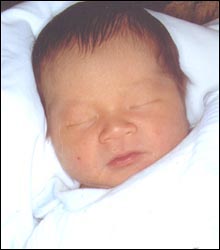
사진 1-15. 좋은 수면습관을 갖게 수면 훈련을 시키려면 신생아기부터 수면 훈련을 잘 시킨다.
Copyright ⓒ 2012 John Sangwon Lee, MD., FAAP

사진 1-16. 영유아들은 잘 때 자기들이 좋아하는 장난감 곰 등 “과도기용 물체“를 안고자거나 옆에 놓고 잔다.
Copyright ⓒ 2012 John Sangwon Lee, MD., FAAP
Balanced diets for children and adolescents and average sleeping hour and nap time daily
소아청소년들의 균형 잡힌 음식물과 소아청소년들의 하루 수면시간과 낮잠 자는 시간
Balanced diets for children and adolescents and average sleeping hour and nap time daily Hippocrates said,
“Let food to be medicine”.
- A good balanced diet is an irreplaceable remedy to strengthen the body and mind.
- There is also a saying that “Food is love”.
- You cannot live without love, you cannot live without food. The best food that can be fed to my newborn baby, needless to say, is mother’s milk (breast milk).
- The method of raising my baby children by feeding my breast milk instead of raising my baby children by feeding artificial nutrition is beneficial not only to mothers, but also to fathers and children, families, and even the country and society.
- It is more economical to raise a baby by breastfeeding than to raise a baby by feeding an artificial nutrition (Infant Formula). In addition, it is beneficial to all babies, nursing mothers, dads, and family members in terms of mind, body, and emotion. In particular, breastfeeding plays a great role in promoting emotional stability between mothers and fathers.
- Children who have grown up with their mother’s breast milk have good humanity, facilitate interpersonal relationships, and grow into productive adults.
- There are so many other good things about breastfeeding. Breast milk is the best food for nursing newborns and infants in a healthy way. Young infants and toddlers who grow up with their mother’s milk are less likely to suffer from various infectious diseases and diseases, and can fight well even if they get sick.
- Breast milk is one of the best supplements. It is a kind of prevention for children and adolescents to eat enough balanced nutritional foods so that they can grow and develop well. It is the responsibility and duty of mothers and fathers to eat enough balanced and nutritious foods to grow strong. Eating enough foods that contain evenly nutrients such as carbohydrates, proteins, fats, vegetables, fruits, moisture, vitamins, and minerals appropriate for your age can be said to be “consume balanced nutritional foods.”
- Most of the total energy you need to do your day-to-day life should come from breakfast.
- For that reason, you must eat breakfast without skipping. Breakfast is the most important of all meals for 24 hours a day. Breakfast becomes the main energy source and the main axis for the day’s activities. For more detailed information about the type, quality and quantity of food to be consumed according to age, the number of times to eat, breast milk, artificial nutrition, baby food, vitamins, etc., parents should also be anti-doctors-Encyclopedia of Child and Family Nursing-Volume 4 Breast Milk , Refer to the reason for breastfeeding.

- Photo 1-9. Carbohydrate foods. Foods of rice, potatoes, barley, wheat, and sweet potatoes are the main components of carbohydrates. Copyright ⓒ 2012 John Sangwon Lee, MD., FAAP

- Photo 1-10. Protein food. Beef, pork, chicken, fish, beans, and milk are protein foods. Copyright ⓒ 2012 John Sangwon Lee, MD., FAAP

- Photo 1-11. Fruit and vegetable foods. Tomatoes, oranges, melons, pananas, strawberries, apples, peaches, onions, peppers, eggplants, cabbages, radishes, chives, grapes, and spinach are foods of fruits and vegetables. Copyright ⓒ 2012 John Sangwon Lee, MD., FAAP

Photo 1-12. Milk and milk products are good foods if they fit the constitution. 87% of milk is water, and the remaining ingredients contain little by little minerals and vitamins such as lactose, butter fat, milk protein and calcium, and sodium. Copyright ⓒ 2012 John Sangwon Lee, MD., FAAP

Photo 1-8. Breast milk is the best and most balanced natural food with a good balance of protein, carbohydrates, fats, vitamins, minerals, and moisture. In particular, there is a lot of love in the mother’s breast. Not only that, it is also very good for the mental and physical health of the nursing mother. Watch your baby’s eye contact love while breastfeeding. Copyright ⓒ 2012 John Sangwon Lee, MD., FAAP
2021 The latest guidelines on food for infants and young children before the age of 2 by the Ministry of Agriculture and Health and Welfare
- Breastfeeding is particularly recommended to prevent obesity and asthma in children and adolescents.
- Eat foods containing iron-calcium, which is specially needed for growth and development.
- Foods that are prone to allergies begin to be fed from 6 months of age.
- Peanut allergy foods begin to be fed from 4 to 6 months of age. Fruit juice or fruit juice with sugar is not given before age 1.
- After infants and toddlers, give balanced Mediterranean foods such as vegetables and fruits that contain minerals and vitamins such as iron, calcium, and vitamin D. sauce; AAP News 2/2021
Enough sleep for children and adolescents

Photo 1-13. Sufficient sleep is essential to maintaining the best mental and physical health. When sleeping newborns or early infants, lay them on their backs to sleep. Copyright ⓒ 2012 John Sangwon Lee, MD., FAAP

Photo 1-14. When sleeping newborns or early infants, it is not recommended to sleep on your stomach on the floor. Food, clothing, shelter, health, love, and sleep are the most necessary basic conditions for humans. Copyright ⓒ 2012 John Sangwon Lee, MD., FAAP
- Depending on the individual, age, environment, lifestyle, etc., the average total sleep time per day required to maintain optimal health varies slightly, normally.
- Therefore, the average total sleep time per day that is best for health cannot be the same depending on age, gender, and lifestyle.
- The average total sleep time per day for most newborns from birth until the first 4 weeks is 15-18 hours.
- According to other studies, it is an average of 20 hours. The daily routine of newborn babies seems to be all about eating, drinking, sleeping, waking up, crying, playing, and sleeping.
- In some newborns, the time to sleep and the time to be awake is clearly indistinguishable. During the first 4 weeks of life, the “24-hour night and day cycle” of newborns is not normally constant. Most of the infants aged 2-3 months after falling asleep can continue to sleep for 3 to 5 hours, then wake up, then eat for an hour or two, play, and sleep again.
- Only when they are 4-6 months old, the “24-hour night and day cycle” of almost all infants becomes constant.
- From this point on, the sleep patterns of infants and young children are also determined according to the “24 hours night and day cycle” of the mother, father and family.
- The sleep patterns of infants are determined according to the sleep patterns of mothers and fathers and their family members, and they can sleep accordingly. The average total sleep time per day for infants and toddlers aged 3 to 15 months is about 15 hours.
Table 1-1. Sleep time and nap time for children and adolescents Sleep time age Total sleep time per day
표 1-1. 소아청소년들의 수면시간과 낮잠 자는 시간
| 수면 시간
나이 Sleep time /age Total |
1일 총 수면 시간
Total sleep time per day |
한번 깨어있는 최장 시간
Maximum time awake once |
1회 자는 최장수면 시간
Maximum time awake once |
1일 낮잠 자는 횟수
Longest sleep time per day
|
최장 낮잠 자는 시간 Maximum number of naps per day |
| 신생아기 (생후 28일까지) Newborn period (until the 28th day of age) | 15∼20 hours | 2 hours | 4hours (3∼5 hours) | – | – |
| 4 months | 15∼20 times | 2.5∼3.5 hours | 8.5 hours | – | – |
| 6 months | 15∼18 hours | – | – | 2∼3 times | |
| 12months | 14∼16 hours | – | – | 1∼2 times | 1∼3시간 |
| 2 years old | 12∼14 hours | – | – | 1∼2 times | 1∼3시간 |
| 2 years old 6 month | 13 hours | – | – | – | – |
| 4∼5 years old | 10∼12 hours | – | – | 주 3∼5회
3∼5 times/a week |
– |
| 10 years old | 10 hours | – | – | – | – |
| 12 years old | 9∼10 hours | – | – | – | – |
| 17 years old | 8∼9 hours | – | – | – | – |
Source: Guide to your child and others & etc
- From a few months before the first birthday to the age of 12-15, the average total sleep time per day starts to get shorter and shorter.
- The average total sleep time per day for adolescent children aged 12-15 years is 9-10 hours.
- If you don’t get enough sleep, it can be like a child or adolescent who doesn’t eat enough food and doesn’t get enough love from mom and dad.
- The average total sleep time per day for adolescent children aged 15 to 18 is about 8 to 9 hours.
- Sleep patterns in newborns and infants vary. During the first few weeks of life, most newborns are hardly able to tell whether they are awake or sleeping.
- Most newborns sleep, wake up, and eat at any time of the day or night, as their normal sleep pattern.
- From 2 to 3 months of age, most infants can have sleep patterns such as sleeping and waking up to some extent during the day and night.
- From the 4th to 6th months of age, the “24-hour night and day cycle” begins to become clear to some extent.
- Some newborns and infants sleep little during the night and a lot during the day.
- Some newborns or infants rarely sleep during the day and sleep mainly at night. Some infants take a little nap,
- Other infants rarely take a nap. In this way, children’s sleeping patterns are normally different and varied.
- Most Tadler infants and toddlers up to the age of 1 or 2 get the total amount of sleep they need that day, mainly at night. Most infants take a nap for at least 1 to 3 hours per day until they are 5 years old. In this way, sleeping patterns vary according to school-age children according to each infant. However, the average total sleep time per day for children is almost the same. Some infants do not take a nap at all from the age of 2 or 3.
- Infants and toddlers can wake up with scary dreams while sleeping. Emotional, mental, or physical problems can prevent you from getting enough sleep. In particular,
- if adolescents cannot fall asleep easily, or if they do not sleep enough, it can be a sign of any mental or physical problem, especially depression.
- The cause must be determined quickly and treated appropriately. Children and adolescents should be frequently checked to see if they are sleeping enough and if their children have sleep problems.
- If a child or adolescent has sleep problems, the sleep problems need to be addressed promptly and appropriately.
- For more information on sleep (sleep), see [Parents should also be anti-doctors-Encyclopedia of Pediatric Family Nursing]-Volume 3, Growth and Development of Newborns, Infants, and School-age and Adolescent Children, Article 12
출처 및 참조문헌
- www.drleepediatrics.com 제1권 소아청소년 응급 의료
- www.drleepediatrics.com 제2권 소아청소년 예방
- www.drleepediatrics.com 제3권 소아청소년 성장 발육 육아
- www.drleepediatrics.com 제4권 모유,모유수유, 이유
- www.drleepediatrics.com 제5권 인공영양, 우유, 이유식, 비타민, 미네랄, 단백질, 탄수화물, 지방
- www.drleepediatrics.com 제6권 신생아 성장 발육 육아 질병
- www.drleepediatrics.com제7권 소아청소년 감염병
- www.drleepediatrics.com제8권 소아청소년 호흡기 질환
- www.drleepediatrics.com제9권 소아청소년 소화기 질환
- www.drleepediatrics.com제10권. 소아청소년 신장 비뇨 생식기 질환
- www.drleepediatrics.com제11권. 소아청소년 심장 혈관계 질환
- www.drleepediatrics.com제12권. 소아청소년 신경 정신 질환, 행동 수면 문제
- www.drleepediatrics.com제13권. 소아청소년 혈액, 림프, 종양 질환
- www.drleepediatrics.com제14권. 소아청소년 내분비, 유전, 염색체, 대사, 희귀병
- www.drleepediatrics.com제15권. 소아청소년 알레르기, 자가 면역질환
- www.drleepediatrics.com제16권. 소아청소년 정형외과 질환
- www.drleepediatrics.com제17권. 소아청소년 피부 질환
- www.drleepediatrics.com제18권. 소아청소년 이비인후(귀 코 인두 후두) 질환
- www.drleepediatrics.com제19권. 소아청소년 안과 (눈)질환
- www.drleepediatrics.com 제 20권 소아청소년 이 (치아)질환
- www.drleepediatrics.com 제21권 소아청소년 가정 학교 간호
- Red book 29th-31st edition 2021
- Nelson Text Book of Pediatrics 19th- 21st Edition
- The Johns Hopkins Hospital, The Harriet Lane Handbook, 22nd edition
- 응급환자관리 정담미디어
-
소아가정간호백과–부모도 반의사가 되어야 한다, 이상원
-
Neonatal Resuscitation American heart Association
-
Neonatology Jeffrey J.Pomerance, C. Joan Richardson
-
Pediatric Resuscitation Pediatric Clinics of North America, Stephen M. Schexnayder, M.D.
-
Pediatric Critical Care, Pediatric Clinics of North America, James P. Orlowski, M.D.
-
Preparation for Birth. Beverly Savage and Dianna Smith
-
Infectious disease of children, Saul Krugman, Samuel L Katz, Ann A. Gershon, Catherine Wilfert
- 소아과학 대한교과서
- Other
Copyright ⓒ 2015 John Sangwon Lee, MD, FAAP
“부모도 반의사가 되어야 한다”-내용은 여러분들의 의사로부터 얻은 정보와 진료를 대신할 수 없습니다.
“The information contained in this publication should not be used as a substitute for the medical care and advice of your doctor. There may be variations in treatment that your doctor may recommend based on individual facts and circumstances. “Parental education is the best medicine.”